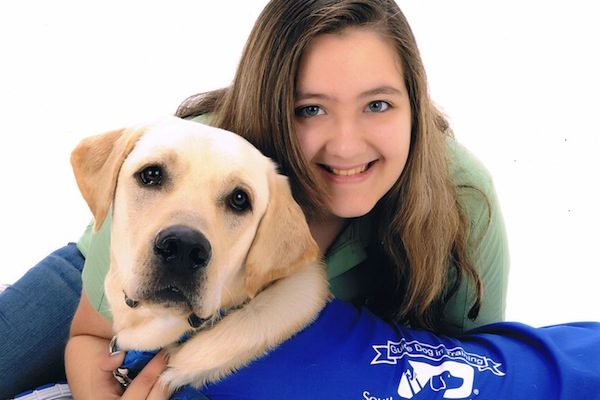I arrived home with a chubby bundle of white fur and floppy ears. It was one week after I finished my freshman year of high school, and I had been anxiously waiting for this day to arrive since Thanksgiving the year before. I had religiously attended six months of training, read the Puppy Raiser Manual cover-to-cover, and had purchased a collar, leash, one month of puppy food, and a crate. At the time, I had no idea just how much the next year would change me, but I was prepared to dive in full-force.

Mike was born in Palmetto, Florida, one of seven puppies born on April Fool’s Day, 2011. He and his litter-mates had no idea what was in store for their future, but their birth was no accident. Their mother, Gigi, was a female breeder for Southeastern Guidedogs, a non-profit organization that specializes in breeding, raising, and training dogs for individuals with visual impairments. Mike would be one of over 2,800 dogs in this organization that would eventually be matched with a lifelong partner. He would be a guide.
The story really started when I filled in an online application to volunteer as a Puppy Raiser. Two weeks later I met Southeastern’s Area Coordinator for my county, Laura. She visited my mom and I at our home with her puppy-in-training, Ricky; a stocky yellow lab, one year old, wearing a leather harness across his shoulders. Laura and Ricky sat on our living room floor for an hour, discussing everything from Southeastern, to our family lifestyle, to dogs and training procedures. Laura’s cheerfulness put us to rest, and Ricky calmly laid by her side as she handed us pamphlets and information cards. We were hooked.

We began attending training meetings twice a month. We left every meeting laughing, with a camera full of pictures and crazy stories. Each meeting was a gathering of 8-10 dogs of varying ages, sizes, colors, and genders. The primary reason for these meetings was to expose the dogs to all kinds of environments; we went to the mall, an ice-skating rink, a firehouse, restaurants, the park, train rides, bus rides, to movies and concerts, sporting events, and an airport. Controlling the dogs around one another was the hardest part, but the most important. These dogs had to be able to handle themselves around anything and everything.
Some meetings involved the welcoming of a brand new puppy into our group. Everyone would take turns cuddling and kissing the new baby, smelling their charming “puppy breath,” and squeezing all of the cuteness out of it. In other meetings, we would have a graduation celebration for a dog on his twelve-month birthday, wishing the dog great luck as he went “IFT,” which is short for “In For Training.” We would all take turns commiserating with each Puppy Raiser as their puppy left to begin his formal training. It was a little easier for the repeat-Raisers to say good bye, because they knew that although they were turning their dog in, they would also be bringing home a fresh puppy. Many families in our group were repeat-Raisers, dedicated families who raised a new puppy almost every year. It takes a strong heart to be a repeat-Raiser, to see dog after dog come and go, but it was worth it.

Every meeting also included some training. As Puppy Raisers, our job was to teach our dogs basic commands at their level. Younger dogs were still mastering “sit.” Older dogs were asked to “find the door,” or “right-about (turn around),” or walk within so many inches of another dog without distraction. By the end of their first year, each dog was able to find and sit at every door, curb, or obstacle. They had to walk in a straight line, or to follow a sidewalk, obey every command, and had to learn self-control while in public. Like any service dog, these puppies had to be extremely well-behaved in every situation. Before obedience, behavior was our primary focus during Puppy Raising.
After a six-month waiting list, we finally brought Mike home. Right away, we started taking him to meetings and settling him in at home. The first two weeks were the hardest. Mike was not fully house-trained, he was separated from his brothers and sisters, and he couldn’t adjust to sleeping through the night. Just like with an infant, messes had to be cleaned, trips and errands had be short, and a strict feeding schedule had to be maintained. However, after the first couple of weeks, Mike became a member of the family.

Proudly wearing his blue cape, Mike would come with us everywhere a seeing-eye dog would go: long car rides, in to church, out to eat, to the grocery store, walks in the park, and even to school. He learned to stay quiet and under the table, to sit at every door, and to behave around strangers. He delighted children, who always wanted to pet him, and he flirted with waitresses– he was a huge charmer! He was also a big dog; the second biggest dog in our group, ever!

In June of 2012, one year after he came home with us, we were asked to bring Mike back to the Southeastern Guidedogs campus. Although I expected it, I was still devastated. Mike was a big part of our family. Everyone at church loved Mike, and we would miss him terribly. The only saving grace was what Mike would be leaving to do.
After a long formal training and matching period, his first match being a bad fit, Mike was finally partnered with Justin. Mike has been helping Justin, mostly-blind, navigate through the world. They have formed a close bond, and Mike is doing what he was trained since birth to do.
As for me, I can’t wait to raise another dog.



Love this. Brings back very fond memories of Mike, my “Grandpuppy”. So glad you wrote this.
It was really fun to write! Thanks 🙂